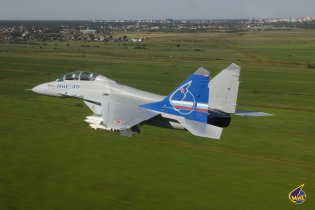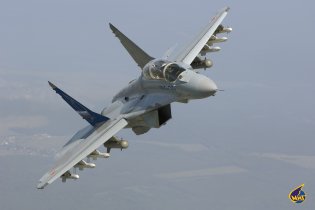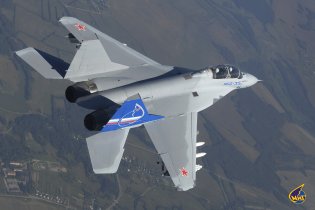MiG-35 Fulcrum Mikoyan
| a | ||||||||||||||||||||||
|
MiG-35 Multirole Frontline Fighter
|
||||||||||||||||||||||
|
|
||||||||||||||||||||||
 |
||||||||||||||||||||||
|
The Mikoyan MiG-35 is a Russian multirole fighter aircraft developed from the MiG-29M/M2 and MiG-29K/KUB fighters. The MiG-35 was officially presented for the first time during Aero India 2007 air show. It performed it maiden flight in late 2009. In November 2016, two MiG-35 fighter jets were given to the Russian Air Force for flight tests in order to confirm the technical characteristics.
The MiG Corporation has been awaiting the RusAF to order the MiG-35 for years. Deputy Defense Minister Yuri Borisov said the military was due to receive 30 aircraft before 2020. Later, Russian Aerospace Force Commander-in-Chief Victor Bondarev said the fighter’s fielding would commence in 2018. |
||||||||||||||||||||||
| Main Variants | ||||||||||||||||||||||
|
- MiG-35D: twin-seat variant
|
||||||||||||||||||||||
| Technical Data | ||||||||||||||||||||||
| Design | ||||||||||||||||||||||
|
The MiG-35 and its twin-seat version, the MiG-35D, are designed for dealing with aerial and static and moving surface threats in any climate and weather. Both aircraft share the design, avionics suite and weapons suite.
The normal takeoff weight of the MiG-35 stands at 19,200 kg and MiG-35D 19,000 kg, with the MTOW of both versions being 24,500 kg. Their maximum speed equals 2,100 km/h at high altitude and 1,400 km/h above the ground and their service ceiling accounts for 16,000 m. The combat radius of the MiG-35 single-seater carrying air-to-air missiles and three drop tanks is 1,000-1,400 km depending in its altitude and weapons fit. When loaded with air-to-surface munitions and three drop tanks, the fighter has a combat radius of 800-1,100 km. The MiG-35D two-seater carrying air-to-air missiles and three external tanks operates at a range of 900-1,300 km away from its base (750-1,050 km, if outfitted with air-to-surface weapons and three external tanks). The maximum operating g-load of both fighters is 9 g. |
||||||||||||||||||||||
|
Propulsion
|
||||||||||||||||||||||
|
The MiG-35/D is powered by a pair of Chernyshev-produced RD-33MK engines. It is the latest version of the RD-33 and was intended to power the MiG-29K and MiG-29KUB. It has 7% more power compared to the baseline model due to the use of modern materials in the cooled blades, providing a higher thrust of 9,000 kgf. The engine features modular design, enhanced reliability and thrust, a smokeless combustor, FADEC control system and extended service life.
The MiG-35/35D’s engines can be equipped with the 360-deg. swiveling nozzle on the customer’s request. The thrust vector control (TVC) afforded by the swiveling nozzle gives the fighter an edge in dogfights. The power plant, comprising two RD-33MK TVC engines, was tested on the MiG-29M OVT (side number 156) prototype aircraft. The single-seater and two-seater can carry two drop tanks under wing and one under the fuselage and are furnished with the in-flight refueling system and PAZ-MK buddy pod. |
||||||||||||||||||||||
|
Avionics
|
||||||||||||||||||||||
|
The MiG-35 and MiG-35D’s avionics suite includes the OLS-UE podded look-down electro-optical (EO) target acquisition system spotting ground threats either independently or using the target designation fed by the targeting/navigation system. The OLK-UE handles target lock-on, autotracking, ranging and illumination as well.
The avionics also includes the MSP-418KE compact active jammer pod. According to MiG Corp., the MSP-418KE from TsNIRTI is designed for individual protection of the MiG-35/35D against current and future surface-to-air missile (SAM) systems and aerial threats by means of active electronic countermeasures (ECM). The MSP-418KE can easily be integrated with the rest of the Fulcrum family. The MSP-418KE embodies the Digital Radio Frequency Memory (DRFM) technology and weighs 150 kg. It can be carried on any of the nine hardpoints of the MiG-35 family’s fighters. The MiG-35 multirole fighter will carry the BINS-SP2 advanced navigation system - an adapted version of KRET’s navigation system equipping ship-based aircraft, KRET First Deputy Director General Igor Nasenkov said. According to him, KRET has released the LINS-100RS system’s design documentation, with the system equipping the MiG-29K/KUB carrierborne fighters. The MiG-35 will have an adapted version designated as BINS-SP2. The navigation system is noiseless and ruggedized and needs no maintenance. Its adaptation to the MiG-35 was to be completed in summer 2016. |
||||||||||||||||||||||
| Armament | ||||||||||||||||||||||
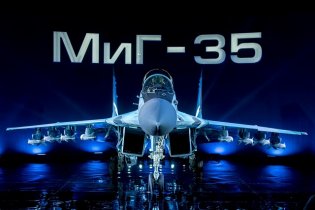 The MiG-35 multirole fighter can carry external payloads weighting up to 6.5 t on 9 hardpoints. The weapons suite of the MiG-35/35 includes the R-77 (NATO reporting name: AA-12 Adder) medium-range and R-73 (AA-11 Archer) dogfight missiles. The multirole fighters can strike surface threats with the Kh-31P, Kh-31PK (AS-17 Krypton), Kh-35E, Kh-35UE (AS-20 Kayak) and Kh-38MLE air-to-surface missiles, KAB-500Kr (OD) smart bombs and a broad spectrum of dumb munitions. It can also carry S-8, S-13, S-24, S-25L, S-250 unguided and laser-guided rockets. The aircraft are outfitted with the 30-mm GSh-30-1 automatic gun with 150 rounds. The MiG-35 multirole fighter can carry external payloads weighting up to 6.5 t on 9 hardpoints. The weapons suite of the MiG-35/35 includes the R-77 (NATO reporting name: AA-12 Adder) medium-range and R-73 (AA-11 Archer) dogfight missiles. The multirole fighters can strike surface threats with the Kh-31P, Kh-31PK (AS-17 Krypton), Kh-35E, Kh-35UE (AS-20 Kayak) and Kh-38MLE air-to-surface missiles, KAB-500Kr (OD) smart bombs and a broad spectrum of dumb munitions. It can also carry S-8, S-13, S-24, S-25L, S-250 unguided and laser-guided rockets. The aircraft are outfitted with the 30-mm GSh-30-1 automatic gun with 150 rounds. |
||||||||||||||||||||||
| Specifications | ||||||||||||||||||||||
|
||||||||||||||||||||||
 |
||||||||||||||||||||||
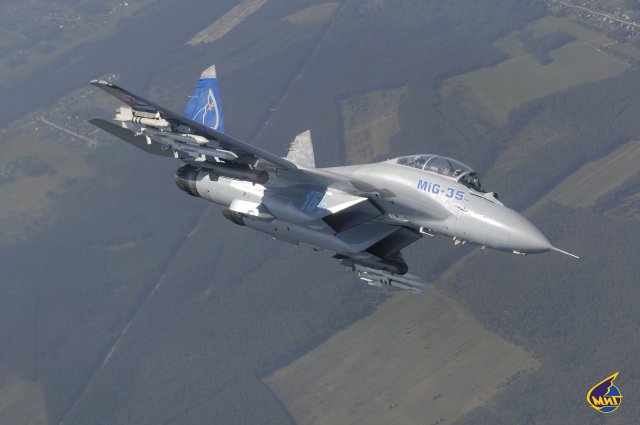 |
||||||||||||||||||||||
|
||||||||||||||||||||||



























